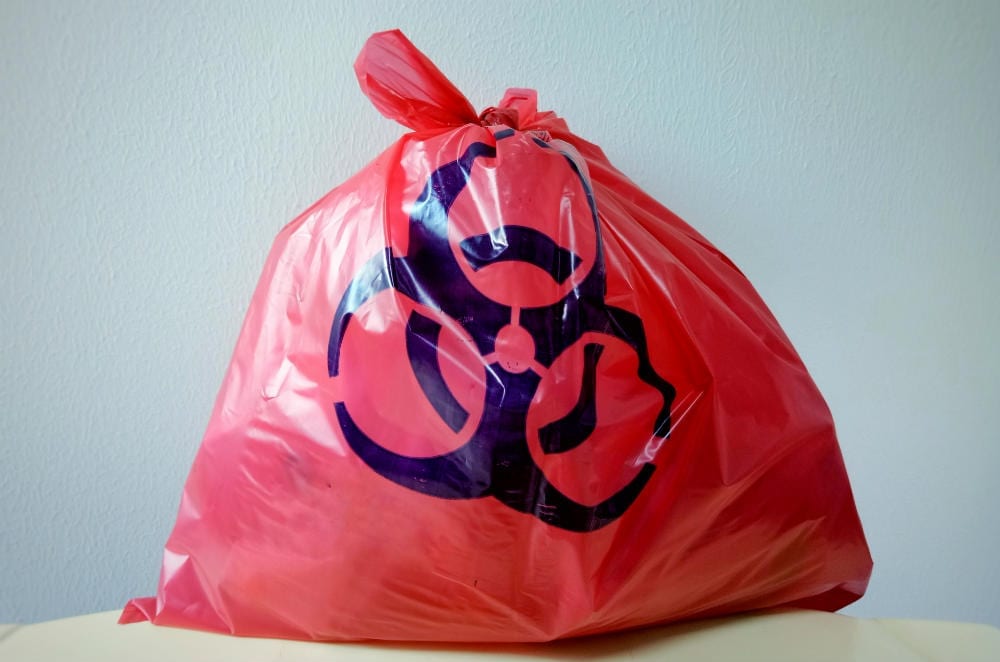There are many misconceptions about what constitutes a biological hazard. On a scientific level, any substance that poses a health risk to living organisms is classified as a biohazard. In order to clarify that in simple terms, we’re taking a look at the four main categories of biohazards, as well as outlining the most common biohazards you are likely to encounter in your home or business.
Since it is impossible to tell if biological agents and pathogens are present without testing, you should treat every situation involving blood, body fluids, and tissue as potentially infectious. This includes any human tissue, animal carcasses, blood, and body fluids, as well as medical waste, drug paraphernalia, and toxic chemicals.
The Most Common Biohazards
Here are some of the most common examples of biological hazards you are likely to encounter in your home or business.
- Pathological Waste – While this includes human tissue from medical procedures, it also encompasses unattached human tissue from an accident or violent crime.
- Human Blood and Blood Products – This includes liquid blood, as well as blood products like plasma and items filled with or soaked in blood.
- Human Body Fluids – Any body fluid in a liquid or semi-liquid state, including semen, vaginal fluid, amniotic fluid, cerebral spinal fluid, and saliva.
- Sharp Items – Sharp items that have come in contact with other biohazards pose a significant risk of contamination. This includes needles, razors, knives, glass, and anything that can puncture the skin.
- Illicit Drugs and Paraphernalia – Illegal drugs pose a risk of intoxication or even overdose. Drug paraphernalia, especially intravenous needles and syringes, can spread biohazards as well.
- Pharmaceutical Waste – This primarily includes pharmaceutical equipment like needles and syringes. However, it also includes expired or unneeded medicine, chemotherapy drugs, and other pharmaceuticals.
- Animal Waste – Carcasses, tissue, and fluids from animals may contain infectious agents. This also includes animal excrement and bedding materials, too.
- Microbiological Waste – While unlikely in the home, specimen cultures, mixing or transferring devices, and other materials related to microbiology have the potential to spread biohazards.
Categories of Biohazard Materials
There are four categories biohazards that identify the types of materials involved and help determine the correct decontamination procedure for biohazard cleanup professionals.
Depending on the circumstances, several categories of biohazard materials may be involved. Due to the risk of contamination, you should assume that all categories of biohazards contain infected materials. For this reason, you should never attempt to clean up biohazardous materials on your own.
Pathological Waste
Pathological waste includes any type of human tissue no longer attached to the body such as flesh, body parts, organs, mouth tissue, and gums. However, this category does not include human teeth.
Outside of a medical environment, the most common cause of pathological waste are accidents and violent crimes. Although a variety of commercial or industrial accents may result in pathological waste, most residential accidents involve kitchen knives. Pathological waste also includes animal carcasses, tissue, and body parts.
Liquid Waste
Liquid waste includes any liquid or fluid from humans or animals. Most commonly this includes blood and blood products like serum and plasma.
Other biohazardous liquids include semen, vaginal fluids, cerebral spinal fluid, synovial fluid, pleural fluid, pericardial fluid, peritoneal fluid, amniotic fluid, and saliva. This also includes blood and fluids from animals.
Materials saturated with liquids are also considered liquid waste during decontamination. This is due to their risk of releasing liquid biohazards when squeezed or pressed. This includes clothing, carpeting, fabric, and upholstery.
Solid Waste
Solid waste includes a wide variety of items exposed to potential biohazard contaminants. Most building materials such as hardwood floors, walls, cabinets, and countertops are included in this category. This also includes dry clothing and fabrics.
Sharp Waste
Sharp waste includes any item in the vicinity of a biohazard contamination that poses a risk of puncturing the skin. This includes medical equipment like needles, syringes, glass slides, and IVs with needles.
In residential, commercial, and industrial environments, this includes knives, razor blades, saws, broken glass, rough metal edges, and any other item that can pierce your skin. These items also increase the risk of injury and contamination during biohazard cleanup procedures.
Levels of Biohazard Contaminations
The Centers for Disease Control (CDC) recognize four levels of biohazard threats. These levels indicate the risk of contamination or infection, how easy the agent spreads, and the safety requirements required to handle or decontaminate the agent involved. All of the categories of biohazards listed above may contain any of these levels of biohazard contaminants.
- Level 1 – Biological agents that pose a minimal threat to humans and the environment. Examples include E. coli and varicella (chickenpox).
- Level 2 – Biological agents that pose a moderate to severe threat to humans and are transmitted via direct contact. Examples include hepatitis A, B, and C, Lyme disease, salmonella, mumps, measles, and HIV.
- Level 3 – Biological agents that pose a severe and potentially fatal risk threat to humans and are transmitted via direct or indirect means, but for which treatments exist. Examples include anthrax, West Nile virus, SARS virus, MERS coronavirus, tuberculosis, typhus, yellow fever, and malaria.
- Level 4 – Biological agents that pose a severe and potentially fatal risk threat to humans, are transmitted via direct or indirect means, and for which there are no treatments. Examples include the Ebola virus and hemorrhagic diseases. Although there is a vaccine, the variola virus (smallpox) is treated as a level 4 biohazard in terms of its quarantine and cleanup procedures.
Get Biohazard Decontamination and Cleanup Services
Due to the risk of contamination, you should assume every biohazard situation has the potential for contamination. Our trained and certified biohazard cleanup specialists are here to safely clean up and restore your home quickly. For emergency response, call 1-888-443-3110 now for a free estimate.





